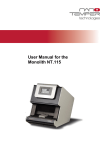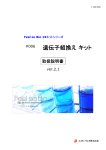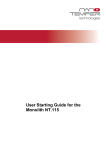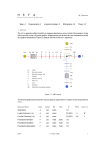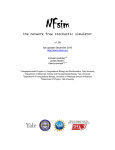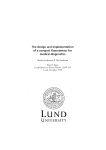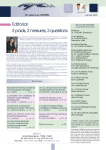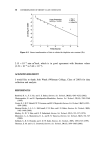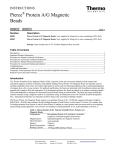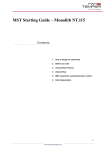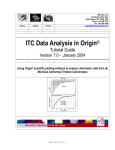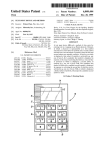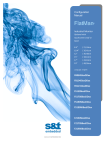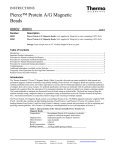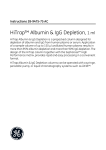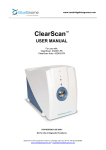Download Monolith NT.115
Transcript
User Manual Monolith NT.115 User Manual User Manual Monolith NT.115 Date July 2011 – Version 10 www.nanotemper.de 1 +49 (0)89 4522895 0 User Manual Contact NanoTemper Technologies GmbH www.nanotemper.de Floessergasse 4 D-81369 München [email protected] phone: +49 89 4522895 0 fax: +49 89 4522895 60 User Manual Monolith NT.115 Date July 2011 – Version 10 www.nanotemper.de 2 +49 (0)89 4522895 0 User Manual Table of Contents Safety Considerations............................................................................................................................... 6 Regulatory Statement............................................................................................................................... 9 Specifications ........................................................................................................................................... 10 Preface ..................................................................................................................................................... 12 Notices ..................................................................................................................................................... 12 Limited Warranty ................................................................................................................................... 13 Installation Requirements ..................................................................................................................... 14 Installation and Connecting Cables ....................................................................................................... 15 Maintenance and Operation .................................................................................................................. 16 Waste Treatment .................................................................................................................................... 17 1. Introduction to Microscale Thermophoresis (MST) ............................................................................ 18 2. Monolith NT.115 Instrument .............................................................................................................. 22 2.1 Models........................................................................................................................................... 22 2.2 Application Range ......................................................................................................................... 22 2.3 Sensitivity ...................................................................................................................................... 22 2.4 Sample Consumption .................................................................................................................... 22 2.5 Capillary Format ............................................................................................................................ 22 2.6 Close-to-Native Conditions ........................................................................................................... 23 2.7 Dedicated Data Acquisition and Analysis Software ...................................................................... 23 3. Sample Preparation ............................................................................................................................. 24 3.1 Control Kit - performing standard experiments ............................................................................ 24 3.2 Selecting the right Monolith NT™ Capillary .................................................................................. 24 Detecting Aggregation ..................................................................................................................... 26 3.4 Quick Start Protocol for Sample Preparation................................................................................. 28 User Manual Monolith NT.115 Date July 2011 – Version 10 www.nanotemper.de 3 +49 (0)89 4522895 0 User Manual You should mix small volumes by pipetting up and down. To Vortex a sample does not work for small volumes. ................................................................................................................................................... 29 4. Preparing Experiments ......................................................................................................................... 30 4.1 Preparing a Molecular Interaction Experiment ............................................................................. 30 4.2 Preparing an Enzyme Reaction Experiment .................................................................................. 33 6. Monolith Instrument Instructions ....................................................................................................... 39 7. Data Acquisition Software ................................................................................................................... 41 7.1 Setting Parameters ......................................................................................................................... 42 7.2 MST assistant: The Concentration finder tool ............................................................................... 45 7.3 Concentration-Input....................................................................................................................... 47 7.4 Instrument Control Functions ....................................................................................................... 48 7.5 Quick Protocol - Microscale Thermophoresis Measurement ........................................................ 52 8. Data Analysis - Theoretical Background .............................................................................................. 53 9. Analysis Software ................................................................................................................................ 56 9.1 Update and Load function.............................................................................................................. 57 9.1.1 loading data in Real Time ........................................................................................................ 57 9.1.2 Load Measurement: ................................................................................................................ 57 9.2 MST-data analysis .......................................................................................................................... 59 9.2.1 Temperature jump and Thermophoresis (Standard) .............................................................. 60 9.2.2 Only Thermophoresis .............................................................................................................. 60 9.2.3 Only Temperature Jump ......................................................................................................... 61 9.2.4 “Hot/Cold”: Deactivation of the automatically analysis ......................................................... 61 9.2.5 Cold Fluorescence ................................................................................................................... 62 9.3 Curve Fitting ................................................................................................................................... 62 9.3.1 Data point removal ................................................................................................................. 64 9.4 Save MST Data................................................................................................................................ 66 User Manual Monolith NT.115 Date July 2011 – Version 10 www.nanotemper.de 4 +49 (0)89 4522895 0 User Manual 9.4.1 Save as an image file ............................................................................................................... 66 9.4.2 Save as a text-file .................................................................................................................... 66 9.5 Generation of MST-Report ............................................................................................................. 66 10. Data Processing of Multiple Experiments .......................................................................................... 67 11. “Typical” Thermophoretic Time Traces.............................................................................................. 69 12. Application Protocols ........................................................................................................................ 71 User Manual Monolith NT.115 Date July 2011 – Version 10 www.nanotemper.de 5 +49 (0)89 4522895 0 User Manual Safety Considerations To ensure operation safety, this instrument must be operated correctly and maintained according to a regular schedule. Carefully read to fully understand all safety precautions in this manual before operating the instrument. Please take a moment to understand what the signal words WARNING!, CAUTION and NOTE mean in this manual. Safety symbols WARNING! CAUTION A WARNING! indicates a potentially hazardous situation which, if not avoided, could result in serious injury or even death. A CAUTION indicates a potentially hazardous situation which, if not avoided, may result in minor or moderate injury. It may also be used alert against damaging the equipment or the instrument. Do not proceed beyond a WARNING! or CAUTION notice until you understand the hazardous conditions and have taken the appropriate steps. NOTE A NOTE provides additional information to help the operator achieve optimal instrument and assay performance. Read manual label. This label indicates that you have to read the manual before using the instrument. This label is positioned at the backside of the device Warning symbol. This symbol indicates laser radiation, it is put on products which have a laser built in. This warning label is positioned at the backside of the device. Identification label. This label is positioned at the backside / rear panel of the device. User Manual Monolith NT.115 Date July 2011 – Version 10 www.nanotemper.de 6 +49 (0)89 4522895 0 User Manual WARNING! Do only operate the Monolith NT.115 instrument with the delivered external power supply (Power Solve PSG60-12-02 or Sinpro Electronics Power Supply SPU63-105). Do only use the delivered cables and plugs. If not doing so you risk electric shock and fire. WARNING! Do not operate the Monolith NT.115 with substances and under conditions which do cause a risk of explosion, implosion or release of gases. Only operate the Monolith NT.115 with aqueous solutions. CAUTION Ensure that the power plug of the external power supply is well accessible. The Monolith NT.115 instrument has to be installed in a way that it does not hinder the access to the external power supply and its power plug. CAUTION The weight of the Monolith NT.115 instrument is approx. 22 kg, do not move the instrument alone (two persons required for transport). If you move the instrument alone it poses a risk of personal injury or damage to the instrument. CAUTION The manual opening of the instrument is not allowed. Manual opening pose a risk of personal injury or damage to the instrument. Contact NanoTemper service personnel if you need to open the instrument. CAUTION The instrument contains an IR-laser module (invisible laser radiation class 3B according to IEC 60825-1: 2007). Lasers or laser systems emit intense, coherent electromagnetic radiation that has the potential of causing irreparable damage to human skin and eyes. The main hazard of laser radiation is direct or indirect exposure of the eye to thermal radiation from the infrared B spectral regions (1,400 nm – 3,000 nm). Direct eye contact can cause corneal burns, retinal burns, or both, and possible blindness. Do not open the instrument while it is switched on. Manual opening of the instrument during operation poses a risk of personal injury or damage to the instrument. When the instrument is used as intended it emits laser radiation of LASER CLASS 1. CAUTION Mechanical moving parts within the instrument can pinch or injure your hands or fingers. Do not touch the instrument while parts are moving. CAUTION The instrument contains a temperature regulator to control the sample temperatures. Some accessible parts of the instrument can reach temperatures up to 50°C. Avoid to touch the temperature controlled parts of the instrument for a longer time when you have set the temperature controller to high temperatures. CAUTION Only NanoTemper stuff is allowed for servicing and opening of the instrument. Turn off the power switch and unplug the power cord before servicing the instrument, unless otherwise noted. Connect the equipment only to the delivered power source. Do not use extension cords. Have an electrician immediately replace any damaged cords, plugs, or cables. Not doing so poses a risk of personal injury or damage to the instrument. User Manual Monolith NT.115 Date July 2011 – Version 10 www.nanotemper.de 7 +49 (0)89 4522895 0 User Manual CAUTION Only open the sample loading site, when moving parts in instrument are at rest. Do not insert or remove a sample while linear actuator, laser or LED is at work. Moving parts in the instrument can be harmful. CAUTION Do not use the instrument in the cold room. CAUTION Turn off the main circuit breaker in the back of the chassis, when the instrument is not in use. CAUTION Do not use ethanol or other types of organic solvents to clean the instrument as they may remove the instrument paint. CAUTION Use the instrument only for biomolecule analytics with aqueous solutions and do not open the instrument on other site than for sample loading. CAUTION Only use aqueous sample for analysis in the instrument. CAUTION Do not use the instrument with hazardous substances or substances/materials which pose a risk of infections. User Manual Monolith NT.115 Date July 2011 – Version 10 www.nanotemper.de 8 +49 (0)89 4522895 0 User Manual Regulatory Statement The following safety and electromagnetic standards were considered: IEC 61010-1:2001 Safety requirements for electrical equipment for measurement, control and laboratory use. Part 1 General Requirements IEC 61010-2-010:2005 Safety requirements for electrical equipment for measurement, control and laboratory use. Part 2-010: Particular requirements for laboratory equipment for the heating of materials. IEC 61010-2-081:2001 Safety requirements for electrical equipment for measurement, control and laboratory use. Part 2-081: Particular requirements for automatic and semi-automatic laboratory equipment for analysis and other purposes. IEC 60825 Laser safety. IEC 61326-1:2006 EMC, Electrical equipment for measurement, control and laboratory use – EMC requirements. IEC 61000-3-2:2006 EMC, Limits for harmonic current emissions (equipment input current up to and including 16A per phase). IEC 61000-3-3:2008 EMC, Limits User Manual Monolith NT.115 Date July 2011 – Version 10 www.nanotemper.de 9 +49 (0)89 4522895 0 User Manual Specifications Input external Power Supply :90–264 VAC ± 10% 47–63 Hz, 230 VA max Output external Power Supply: 12 VDC, 5.0 A max, 2.4 A typical Electrical Input Monolith NT.115 instrument: 12 VDC, 5A Environmental Operating temperature 15 – 30°C (Indoor use only) Storage temperature -20 – 30°C Humidity 0–80%, noncondensing Operating altitude max 2000m Monolith NT.115 Size width 33 cm (13”) height 45 cm (17.5”) depth 51 cm (20”) Weight 22 kg (51 lbs) net Power Supply Size width 10.6 cm (4.2”) height 3 cm (1.2”) depth 6.5 cm (2.6”) Power Supply Weight 0.23 kg (0.51 lbs) net max IR-Laser Wavelength: 1475 nm +/- 15 nm Power: 120 mW max. Monolith NT.115 Laser classification Device is LASER PRODUCT CLASS 1 Temperature Control Range: 20°C – 50°C (at Room Temperature 25°C) Accuracy: +/- 0.3°C Noise Level of Monolith NT.115 instrument: max. 64 dB(A) User Manual Monolith NT.115 Date July 2011 – Version 10 www.nanotemper.de 10 +49 (0)89 4522895 0 User Manual Connections All ingoing and outgoing connections can be found at the rear panel of the instrument. Name Function Ethernet Connector for connecting the Ethernet cable to the PC/Notebook USB Connector for connecting the USB cable to the PC/Notebook. Only used for service by NanoTemper service. Power Switch When the switch is pressed on (position “I”), the instrument is switched on. DC Input The connector to the external power supply. Connect with the external power supply. User Manual Monolith NT.115 Date July 2011 – Version 10 www.nanotemper.de 11 +49 (0)89 4522895 0 User Manual Preface This manual is your guide for using the Monolith NT.115 and doing Microscale Thermophoresis (MST) measurements. It instructs first-time users on how to use the instrument, and serves as a reference for experienced users. Before using the Monolith NT.115 instrument, please read this instruction manual carefully, and make sure that the contents are fully understood. This manual should be easily accessible to the operator at all times during instrument operation. When not using the instrument, keep this manual in a safe place. If this manual becomes lost, order a replacement from NanoTemper Technologies GmbH. Notices 1. 2. 3. 4. 5. 6. 7. NanoTemper shall not be held liable, either directly or indirectly, for any consequential damage incurred as a result of product use. Prohibitions on the use of NanoTemper software Copying software for other than backup Transfer or licensing of the right to use software to a third party Disclosure of confidential information regarding software Modification of software Use of software on multiple workstations, network terminals, or by other methods The contents of this manual are subject to change without notice for product improvement. This manual is considered complete and accurate at publication. This manual does not guarantee the validity of any patent rights or other rights. If a NanoTemper software program has failed causing an error or improper operation, this may be caused by a conflict from another program operating on the Notebook (PC). In this case, take corrective action by uninstalling the conflict product(s). NanoTemper is a registered trademark of NanoTemper Technologies GmbH in Germany and other countries. User Manual Monolith NT.115 Date July 2011 – Version 10 www.nanotemper.de 12 +49 (0)89 4522895 0 User Manual Limited Warranty Products sold by NanoTemper, unless otherwise specified, are warranted for a period of one year from the date of shipment to be free of defects in materials and workmanship. If any defects in the product are found during this warranty period, NanoTemper will repair or replace the defective part(s) or product free of charge. THIS WARRANTY DOES NOT APPLY TO DEFECTS RESULTING FROM THE FOLLOWING: 1. 2. 3. 4. 5. IMPROPER OR INADEQUATE INSTALLATION. IMPROPER OR INADEQUATE OPERATION, MAINTENANCE, ADJUSTMENT OR CALIBRATION. UNAUTHORIZED MODIFICATION OR MISUSE. USE OF UNAUTHORIZED CAPILLARIES AND CAPILLARY TRAYS. USE OF CONSUMABLES, DISPOSABLES AND PARTS NOT SUPPLIED BY AN AUTHORIZED NANOTEMPER DISTRIBUTOR. 6. CORROSION DUE TO THE USE OF IMPROPER SOLVENTS, SAMPLES, OR DUE TO SURROUNDING GASES. 7. ACCIDENTS BEYOND NANOTEMPER’S CONTROL, INCLUDING NATURAL DISASTERS. This warranty does not cover consumables like capillaries, reagents, labeling kits and the like. The warranty for all parts supplied and repairs provided under this warranty expires on the warranty expiration date of the original product. For inquiries concerning repair service, contact NanoTemper after confirming the model name and serial number of your NanoTemper instrument. User Manual Monolith NT.115 Date July 2011 – Version 10 www.nanotemper.de 13 +49 (0)89 4522895 0 User Manual Installation Requirements To ensure operation safety, observe the following conditions: 1. Do only operate the Monolith NT.115 instrument with the delivered external power supply (Power Solve PSG60-12-02 or Sinpro Electronics Power Supply SPU63-105). 2. Only connect the external power supply of Monolith NT.115 to an electrical socket containing a protective conductor terminal). 3. Ensure that the power plug of the external power supply is well accessible. The Monolith NT.115 instrument has to be installed in a way that it does not hinder the access to the external power supply and its power plug. 4. Only operate the instrument with the delivered PC (Notebook). 5. Only operate the instrument with original Monolith NT.115 capillary trays. 6. The maximum noise level of the instrument is 64dB(A). Only operate the instrument in an environment where this noise level is appropriate. 7. Operate the instrument in a temperature range of 15 – 30 °C. 8. Operate the instrument in a humidity range of 0 – 80 % (RH). If ambient humidity exceeds 80 % (RH), condensation may deteriorate optical components. 9. Operate the instrument in an atmospheric pressure range of 800 – 1060 hPa. 10. Do not operate the Monolith NT.115 under conditions which pose a risk of explosion, implosion or the risk of the release of gases. 11. Avoid strong magnetic fields and sources of high frequency. The instrument may not function properly when near a strong magnetic field or high frequency source. 12. Avoid vibrations from vacuum pumps, centrifuges, electric motors, processing equipment and machine tools. 13. Avoid dust and corrosive gas. Do not install the instrument where it may by exposed to dust, especially in locations exposed to outside air or ventilation outlets. 14. For cleaning the instrument, only use water. 15. Do not install the instrument in a location where it may be exposed to direct sunlight. 16. Install the instrument in a horizontal and stable position. (This includes a table, bench or desk upon which the instrument is installed). 17. Ensure that no air conditioner blows air directly onto the instrument. This may prevent stable measurements. 18. Install the instrument in a location that allows easy access for maintenance. NOTE: The above conditions do not guarantee optimal performance of this instrument. User Manual Monolith NT.115 Date July 2011 – Version 10 www.nanotemper.de 14 +49 (0)89 4522895 0 User Manual Installation and Connecting Cables Preparation Prepare a table which can bear a weight of about 50 kg and has a free area of 80 cm (width) x 50 cm (depth). Put the Monolith NT.115 instrument and the Notebook to this free area. CAUTION The weight of the Monolith NT.115 instrument is approx. 22 kg, do not move the instrument alone (two persons required for transport/movement). If you move the instrument alone it poses a risk of personal injury or damage to the instrument. Connecting the Power Supply and the Monolith NT.115 Confirm that the power switch of the Monolith NT.115 instrument is off (power switch is at the backside, left of the instrument). WARNING! Do only operate the Monolith NT.115 instrument with the delivered external power supply (Power Solve PSG60-12-02 or Günter Power Supplies SPU63-105). Do only use the delivered cables and plugs. If not doing so you risk electric shock and fire. Connect the external power supply to the electrical socket. Then connect the power supply to the Monolith NT.115 instrument. CAUTION Ensure that the power plug of the external power supply is well accessible. The Monolith NT.115 instrument has to be installed in a way that it does not hinder the access to the external power supply and its power plug. Connect the Monolith NT.115 instrument to the Notebook by using the delivered network cable. Switch on the Monolith NT.115 and the Notebook. User Manual Monolith NT.115 Date July 2011 – Version 10 www.nanotemper.de 15 +49 (0)89 4522895 0 User Manual Maintenance and Operation Pay attention to the instrument operating environment and always keep it clean so that the instrument can be used in a stabilized condition over a long period. Do not place anything on the instrument. Cleaning the Monolith NT.115 instrument Switch off the instrument and remove the power plug of the external power supply from the electrical socket. Only use dry cloth or cloth wetted with water for cleaning of the instrument. CAUTION Do not use ethanol or other types of organic solvents to clean the instrument as they may remove the instrument paint. Transporting the Monolith NT.115 instrument Switch off the instrument and remove the power plug of the external power supply from the electrical socket. Do not carry the instrument alone, two people are need for transportation. CAUTION The weight of the Monolith NT.115 instrument is approx. 22 kg, do not move the instrument alone (two persons required for transport/movement). If you move the instrument alone it poses a risk of personal injury or damage to the instrument. Functional Disorder In case of a functional disorder switch off the Monolith NT.115 instrument and wait for five minutes, then switch on the instrument again. If there is still a functional disorder switch off the device, unplug the power cable and contact the NanoTemper service. Repairing the Monolith NT.115 instrument Do not try to repair the instrument by yourself. Do contact the NanoTemper service for repairing the instrument. CAUTION The manual opening of the instrument is not allowed. Manual opening pose a risk of personal injury or damage to the instrument. Contact NanoTemper service personnel if you need to open the instrument. User Manual Monolith NT.115 Date July 2011 – Version 10 www.nanotemper.de 16 +49 (0)89 4522895 0 User Manual Waste Treatment Waste treatment is your own responsibility. You must hand it to a company specialized in waste recovery. Do not dispose the instrument in a litter bin or at a public waste disposable site. For detailed information please contact the NanoTemper service. User Manual Monolith NT.115 Date July 2011 – Version 10 www.nanotemper.de 17 +49 (0)89 4522895 0 User Manual 1. Introduction to Microscale Thermophoresis (MST) Microscale Thermophoresis is a powerful new technology, and easy to handle. It measures changes in the hydration shell of molecules and allows to quantify enzyme kinetics or to measure biomolecule interactions under close-to-native conditions. Virtually any biochemical process relating to the interaction, size, stability or conformation of biomolecules and biochemical complexes can be measured with high sensitivity. 150 years ago Charles Soret and Carl Ludwig (1) discovered that molecules move in temperature gradients, a physical effect called thermophoresis. Extensive research conducted at the Biophysics Department of the Ludwig-Maximilians-University Munich (LMU) identified the solvation entropy and the hydration shell of molecules as the driving force (2). Today, with the availability of IR-lasers, precise temperature gradients on the microscale can be rapidly induced within thin glass capillaries, enabling the study of biomolecule interaction and activity. User Manual Monolith NT.115 Date July 2011 – Version 03 www.nanotemper.de 18 +49 (0)89 4522895 0 User Manual A B Figure 1. Microscale Thermophoresis: A fluorescence excitation light source and detector is used with an additional hot mirror inserted into the path of fluorescence light. With this mirror, the heating IR-Laser couples into the path of fluorescence light and is focused with the same objective used for fluorescence detection. This allows observation of thermophoresis in thin glass capillaries. Fluorescently labeled molecules or particles are initially distributed evenly and diffuse freely in solution. By switching on the IR-Laser, the molecules experience a thermophoretic force in the temperature gradient and typically move out of the heated spot. In the steady state, this molecule flow is counterbalanced by ordinary mass diffusion. After turning off the laser, the particles diffuse back towards a homogeneous distribution. Different kinds of information can be observed from such experiment: Fluorescence signal before turning the laser on, fast temperature-dependent changes (MST T-Jump) in fluorescence intensity of the analyzed molecules, thermophoresis and back diffusion after switching the laser off. The Microscale Thermophoresis Technology can detect even weak binding events which are typically difficult to access, like the binding of small molecules or single ions to proteins (3,4). Furthermore, it can be used to study the activity of molecules including enzymatic modifications of substrates or competitive binding of inhibitors and substrates to an enzyme. The interaction of biomolecules (small molecules, DNA, RNA, proteins, peptides, sugars, lipids, ribosomes etc) can be measured under close-to-native-conditions: - immobilization-free in a solution of choice, ranging from standard and proprietary buffers to complex bioliquids including blood serum or cell lysates User Manual Monolith NT.115 Date July 2011 – Version 03 www.nanotemper.de 19 +49 (0)89 4522895 0 User Manual Microscale Thermophoresis can be used to: NanoTemper´s unique MST technology allows to - - - measure affinities (KD, dissociation constant) between any (bio)molecules directly in bioliquids. study the effect of serum, cell lysate or other bioliquids on biomolecules and to separate multimerization, aggregation and other artifacts from true binding events. study membrane bound proteins directly in membranes. study multi component reactions or biochemical fractions containing. enzymatic activities, complex formation, order of assembly, interfering factors in the medium. access larger screening projects in a “label-free” manner using fluorescently labeled competitors (“Competitive MST”). discriminate between different binding sites on a target of interest study the enzyme kinetics (vmax, kcat). study the stoichometry and determine the number of binding sites of biomolecules. study the binding ernergetics G (free energy ), H (enthalpy) and S (entropy). study the inhibitor affinity, Ki either directly or in a competition experiment. Figure 2. Scetch of the thermophoretic effect. Binding of an antigen to a fluorescently labeled antibody changes its thermophoretic motion in the temperature gradient. For example the complex moves from lower to higher temperatures, while the free antibody moves in the opposite direction. Thus the fluorescence increases where the solution is heated, when there is a binding event. Also a slightly slower or faster motion without change of direction is detectable with thermophoresis. User Manual Monolith NT.115 Date July 2011 – Version 03 www.nanotemper.de 20 +49 (0)89 4522895 0 User Manual References: (1) Ludwig, C. Sitzungsber. Akad. Wiss. Wien: Math.-Naturwiss. 20, 539 (1856) (2) Stefan Duhr and Dieter Braun. Why molecules move along a temperature gradient PNAS 103, 19678–19682 (2006) (3) Philipp Baaske, Christoph J. Wienken, Philipp Reineck, Stefan Duhr and Dieter Braun. Optical Thermophoresis for Quantifying the Buffer Dependence of Aptamer Binding. Angewandte Chemie International Edition, 49, 2238-2241 (2010) (4) Christoph J. Wienken, Philipp Baaske, Ulrich Rothbauer, Dieter Braun and Stefan Duhr Protein Binding Assays in Biological Liquids using Microscale Thermophoresis Nature Communications, DOI: 10.1038/ncomms1093 (2010) User Manual Monolith NT.115 Date July 2011 – Version 03 www.nanotemper.de 21 +49 (0)89 4522895 0 User Manual 2. Monolith NT.115 Instrument 2.1 Models Monolith Instrument NT.115 Blue/Green NT.115 Blue/Red NT.115 Green/Red LED 1 LED 2 Blue Dyes Green Dyes Red Dyes FITC/FAM/GFP/YFP Cy3/RFP/mCherry no detection FITC/FAM/GFP/YFP no detection Cy5/Alexa647 YFP Cy3/RFP Cy5/Alexa647 2.2 Application Range Monolith NT.115 allows to measure the binding of all kinds of biomolecules (KD = 1 nM – 500 mM) as well as the activity of enzymes. Higher Affinities are accessible in competition experiments. 2.3 Sensitivity Monolith NT.115 can measure as little as the binding of single ions (40Da) or small molecules (300Da) to a target as well as the binding of large complexes such as ribosomes (2.5MDa). 2.4 Sample Consumption The Monolith NT.115 requires only little sample material: >1 nM of the labeled compound and a titration of the unlabelled compound in the range of ± factor 10-20 of the expected dissociation constant. For standard applications, 5μl of sample material is filled in the capillary. 2.5 Capillary Format The capillary format used for the Monolith NT.115 is inexpensive, easy to handle and offers a maximum of flexibility in the experiment scale. The standard sample tray format allows to process automatically up to 16 capillaries (e.g. for a detailed KD-analysis), or alternatively to perform smaller pilot experiments involving only 2-3 sample concentrations. User Manual Monolith NT.115 Date July 2011 – Version 03 www.nanotemper.de 22 +49 (0)89 4522895 0 User Manual 2.6 Close-to-Native Conditions Monolith NT.115 can monitor the binding and the biochemical activity of biomolecules under close-to-native conditions: - immobilization-free - In a solution of choice, ranging from standard and proprietary buffers to complex bioliquids including blood serum, cell lysates and the like. 2.7 Dedicated Data Acquisition and Analysis Software The Monolith NT.115 is supported by a software for data acquisition and analysis. User Manual Monolith NT.115 Date July 2011 – Version 03 www.nanotemper.de 23 +49 (0)89 4522895 0 User Manual 3. Sample Preparation For detailed information about handling capillaries please read chapter 5. 3.1 Control Kit - performing standard experiments Control Kits containing standardized sample material are recommended - when using the Monolith NT.115 instrument for the first time - for monitoring the correct performance of the Monolith NT.115 - for training of new lab employees Optimized Control Kits for use in Microscale Thermophoresis are available either with red-fluorescent or with blue-fluorescent labeled bio-molecules. The kits contain a fluorescent-labeled DNA-molecule, unlabeled binding partner and buffer. Cat # MT Control Kits Reactions C030 Monolith NT™ Control Kit RED Molecular Interaction Control Kit for Monolith NT.115 BLUE/RED or Monolith NT.115 GREEN/RED Monolith NT™ Control Kit GREEN Molecular Interaction Control Kit for Monolith NT.115 BLUE/GREEN or Monolith NT.115 GREEN/RED Monolith NT™ Control Kit BLUE Molecular Interaction Control Kit for Monolith NT.115 BLUE/RED or Monolith NT.115 BLUE/GREEN 5 C031 C032 5 3.2 Selecting the right Monolith NT™ Capillary In order to avoid experimental artifacts, which can be caused by protein adsorbance to the glass capillary or by protein aggregations, it is recommended to determine the best Monolith NT™ Capillary type for a bio-molecule of interest by performing the following experiment: - - Load 5 Monolith NT™ Standard Treated Capillaries with 100 nM (or at working concentration) of the labeled biomolecule of interest after diluting it with the buffer that is intended to be used in the experiment. Place the capillary on the tray and insert the tray in the instrument. Chose a folder where to save the scan data and a LED color/power. User Manual Monolith NT.115 Date July 2011 – Version 03 www.nanotemper.de 24 +49 (0)89 4522895 0 User Manual - Close the chassis and start a capillary scan by pushing the “find capillaries” button. If a “u-shape” (i.e. split peak) is observed, instead of a distinct fluorescence peak, it your sample absorbs to the capillary wall. See figure below (left 3 capillaries): Sticking Sample/False Capillary Not Sticking Sample (ok) In this case it is recommended to use Monolith NT™ Hydrophobic and Hydrophilic Capillaries which in almost all cases prevent the absorbance to the capillary glass walls. Cat # Monolith NT™ Capillaries Content K001 Monolith NT™ Capillaries Starter Set K002 Monolith NT™ Standard Treated Capillaries K003 Monolith NT™ Hydrophobic Capillaries K004 Monolith NT™ Hydrophilic Capillaries 50 Monolith NT™ Standard Treated Capillaries 50 Monolith NT™ Hydrophobic Capillaries 50 Monolith NT™ Hydrophilic Capillaries Sealing Wax 1000 Capillaries Sealing Wax 200 Capillaries Sealing Wax 200 Capillaries Sealing Wax User Manual Monolith NT.115 Date July 2011 – Version 03 www.nanotemper.de 25 +49 (0)89 4522895 0 User Manual NOTE: Random variations of fluorescence counts can also be caused by adsorption of the biomolecule to the micro reaction tubes. In this case, a detergent or BSA may be used, a higher sample volume may be prepared or low adsorption micro reaction tubes may be deployed. 3.3 Checking the Sample Quality Detecting Aggregation In addition, the potential aggregation behavior of the biomolecule of interest can be tested with microscale thermophoresis. Often protein preparation contain aggregates that are very difficult to observe with standard methods. To test for the quality of your preparation perform the following experiment with your molecule of interest at working concentration and in the intended buffer: Start a measurement with the following setting: - LED power adjusted to you sample concentration - Laser power 40% - Laser on time 30 seconds - Laser off time 5 seconds In case that the biomolecule of choice aggregates, the fluorescence signal during the “laser on time” is “bumpy”. This is because aggregates are transported into the measurement volume by a convective flow induced by local heating. In such cases: Centrifuge you sample before using it in a MST experiment (5 minutes, 13,000 rpm, 4°C). Actually, we recommend to centrifuge any stock of the sample before it is used in MST. You may also use detergents such as Tween-20 (0,01 % - 0,1 %) or Triton-X-100 (0,01 % – 0,1 %). User Manual Monolith NT.115 Date July 2011 – Version 03 www.nanotemper.de 26 +49 (0)89 4522895 0 User Manual No Aggregates Some Aggregates – better sample preparation needed Many Large Aggregates – better sample preparation needed User Manual Monolith NT.115 Date July 2011 – Version 03 www.nanotemper.de 27 +49 (0)89 4522895 0 User Manual 3.4 Quick Start Protocol for Sample Preparation Prerequisite and general remarks: - One substrate should be fluorescently labeled. Make sure, that there isn’t any not reacted, free dye in your sample (it is best to use the NanoTemper labeling kit manual). - Prepare at least 20µl of sample per capillary to avoid pipetting error and changes in concentration due to sample evaporation. You will need approx. 5µl to fill a capillary. - The concentration of the labeled molecule is always kept constant. The unlabeled compound is varied in concentration. - Do not use less than 10 capillaries for an analysis of interaction. - The observed fluorescence counts of the labeled sample in the respective dilution should be about 80-1500 fluorescence counts when measured with the Monolith NT.115. - The concentration of the labeled molecule should be in the range of the expected KD or less. - The concentration of the titrated compound should vary from about 20x to 0,02x the expected KD. 1. Spin down the stocks of the fluorescently labeled molecule and the molecule you intend to titrate in a serial dilution (5min, 13000 rpm in a table top centrifuge). 2. Check the buffer composition of the labeled compound and the compound that is titrated. 3. Prepare a stock solution of the fluorescently labeled molecule at twice the concentration you want to use in the experiment. Prepare at least 200µl (10µl x 16 Capillaries + 1-5 Test measurements). Use the buffer you want to use for determining the affinity. 4. Mix the stock well and test the fluorescence intensity in a capillary in the NT.115 instrument and test the sample as suggested in the manual at 3.2 and 3.3. 5. Put the stock on ice and protect it from light. 6. Prepare small 16 micro reaction tubes, best suited are tubes with a volume of 100µl or less. Do not use reaction tubes with higher volume for volumes of 20µl or less. This may lead to strong evaporation and may change concentration due to a low volume to surface ratio in the tube. Number them from 1 through 16. 7. Fill 20µl of the highest concentration you intend to use in the first micro reaction tube number 1. 8. Fill 10µl of the buffer you want to use for dilution into the micro reaction tubes 2 to 16. Please note: The buffer in tube number one and the buffer in the other tubes User Manual Monolith NT.115 Date July 2011 – Version 03 www.nanotemper.de 28 +49 (0)89 4522895 0 User Manual 9. 10. 11. 12. must be the same. Otherwise you get a gradient in salt, DMSO, glycerol or other additives. This interferes with the thermophoretic measurement. Transfer 10µl of tube number one to tube number two and mix very well by pipetting up and down several times. Change the tip of the pipet and transfer 10µl in the next tube. Repeat this 15 times and remove 10µl from tube number 16 after mixing. Mix 10µl of fluorescently labeled sample with the 10µl of the titrated compound and mix well by pipetting up and down several times. Please note that you only have half the concentration you initially had. (It is more precise to prepare 15 µl of the titrated sample, transfer 10µl to fresh tubes and then mix with 10µl of the labeled molecule) Incubate the sample at conditions of your choice before filling it into the capillaries. Incubation temperature and time can differ between different molecules. In most cases 30-60 minutes incubation at room temperature are sufficient. NOTE: You should mix small volumes by pipetting up and down. To Vortex a sample does not work for small volumes. User Manual Monolith NT.115 Date July 2011 – Version 03 www.nanotemper.de 29 +49 (0)89 4522895 0 User Manual 4. Preparing Experiments 4.1 Preparing a Molecular Interaction Experiment For performing a molecular interaction experiment and measuring the dissociation coefficient (KD), a titration series of up to 16 dilutions is prepared, where the concentration of the fluorescent binding partner is kept constant and the concentration of the unlabeled binding partner is varied. Do not use less than 10 capillaries. NOTE: Also competition experiment can be performed to analyze interactions. E.g. a complex between two proteins is formed, one of them fluorescently labeled. The concentration of this complex is kept constant, and a small molecule or any other competitor is titrated to this complex. When the small molecule is capable of separating the proteins, it is observed in thermophoresis. Thus a functional assay is performed. Prepare the labeled binding partner: Ideally the ratio of label to protein (DEG, degree of labeling) is 1:1 or less. Unbound label has to be eliminated from the labeling mixture, completely. The concentration of the protein should be close to the expected KD or less and should yield a range of 80-1500 fluorescence counts (typically equivalent to 1-200 nM) when measured with the Monolith NT.115. The following kits offer optimized fluorescence labeling and purification protocols for use in Microscale Thermophoresis. The dyes are widely tested with thermophoresis and the protocols are optimized to remove free, unreacted dye: User Manual Monolith NT.115 Date July 2011 – Version 03 www.nanotemper.de 30 +49 (0)89 4522895 0 User Manual Cat # -MT Grade- Protein Labeling Kits Reactions L001 Monolith NT™ Protein Labeling Kit RED 4x 100-500 µg Protein L002 Monolith NT™ Protein Labeling Kit GREEN 4x 100-500 µg Protein L003 Monolith NT™ Protein Labeling Kit BLUE 4x 100-500 µg Protein Prepare the unlabeled binding partner Prepare a 16step dilution series around the expected KD, starting from a concentration of 20fold the expected KD, down to 0.02 fold the expected KD. Prepare the samples with a twofold higher concentration, since mixing volume ratio of 1:1 decreases the concentration by a factor of 2. Use sufficiently small micro reaction tubes to avoid evaporation of the sample (e.g. with a volume <100µl when preparing 10-20µl of sample). Binding reaction Prepare a serial dilution of the not labeled binding partner and fill 10μl of each sample of the dilution series in to 16 small micro reaction tubes. Fill 10 μl of a 2x stock solution of the labeled binding partner into the same 16 tubes and mix very well. Incubate the samples in the dark. Incubation time and temperature can differ between different molecules and should be tested in a pilot experiment by the researcher. In most cases 30-60 minutes incubation at room temperature are sufficient. Transfer the binding reaction into Monolith NT™ Capillaries: After an incubation time sufficient for the reaction to reach equilibrium, 5 μl of each binding reaction is aspirated into Monolith NT™ Capillaries (see chapter 5). User Manual Monolith NT.115 Date July 2011 – Version 03 www.nanotemper.de 31 +49 (0)89 4522895 0 User Manual KD of binding of molecule X to Y = 50 nM. Titration series range: 1000 nM – 0.025 nM Concentration of Binder Y = 1 mM in Buffer YB I. Dilution Conc. Y Series (nM) 1 1000 2 500 3 250 4 125 5 62.5 6 31.2 7 15.5 8 7.7 9 3.7 10 1.8 11 0.90 12 0.45 13 0.22 14 0.11 15 0.05 16 0.025 Prepare the highest concentration of the dilution series by adding 1µl of Compound Y to 0.5ml buffer of choice (2µM). This dilution No.1 still contains traces of buffer YB. II. Prepare the Series-dilution-buffer (SD-buffer) that has the same constituents the dilution No.1 has (e.g. DMSO, Glycerol etc.). III. Transfer 15µl SD-buffer to 15 0.2ml tubes (No.2 – 16). IV. Transfer 15µl with a clean tip from the first 0.2ml vial (2µM compound Y from step I) to the second vial and mix well by pipetting. V. With a clean tip transfer 15µl from the second vial to the third vial and mix well. Continue this 2-fold serial dilution until tube number 16. VI. Transfer 10µl from No.1 – 16 in new reaction tubes and add 10µl of your fluorescently labeled sample e.g. 100nM to the tube. VII. Mix very well by pipetting to obtain good results. NOTE: 1. centrifuge stock solutions before usage to remove aggregates. 2. When the highest concentration of binder has a significant concentration of an additional buffer component (e.g. 3% DMSO), then the buffer used for dilution has to contain the additive in same concentration. The same holds true for differences in ionic strength or pH, BSA or glycerol. 3. The Monolith NT.115 has a highly precise fluorescence detection and insufficiently mixed samples will be highlighted by random fluctuating fluorescence intensity signals. If sample are well mixed, a random fluctuation of 10% or even less is achieved. User Manual Monolith NT.115 Date July 2011 – Version 03 www.nanotemper.de 32 +49 (0)89 4522895 0 User Manual 4.2 Preparing an Enzyme Reaction Experiment When analyzing an enzymatic reaction with Microscale Thermophoresis the substrate should be fluorescently labeled (e.g. peptide or DNA). A fluorescently labeled peptide can be purchased from various providers. In case of an enzymatic reaction modifying a DNA molecule, also an intercalating dye can be used to monitor the thermophoretic changes. When preparing an experiment to analyze the enzymatic activity, the ratio between substrate and enzyme has to be carefully chosen. Too high enzyme concentration or low amount of substrate will lead to a very fast conversion of the substrate to the reaction product. It is recommended to slow down the reaction kinetics (to > 10 minutes) in order to be able to start the analysis before a significant part of the substrate is already converted. Since enzyme kinetics vary between different enzyme reactions it is recommended to adjust the reaction conditions and the concentration of enzyme and substrate. In order to reach optimal results use a low amount of enzyme and an excess amount of substrate. It is recommended to start a new experiment with 1-10 nM enzyme or less and 10 μM substrate. NOTE: Use only a little amount of enzyme and use substrate in excess. You can mix fluorescently labeled substrate and not labeled substrate, if the conversion of these molecules to a product is similar. To analyze an enzymatic reaction you should at least prepare two samples. One containing the substrate and all cofactors necessary. The second “negative Control” should contain the substrate but it should lack an essential cofactor (e.g. ATP, S-adenosylmethionin, etc.) or contain an inhibitor. Prepare approx. 10 μl of these samples. Add the enzyme to both solutions so and mix thoroughly and fast. Prepare the samples fast on ice. Transfer both samples in to a capillary (see below) and start the measurement using the Monolith analysis software and choose the number of repeats and a delay time (0 = fastest repetition). NOTE: If you want to check if the enzymatic reaction is specific or you want to increase signal strength, you can add a molecule into the sample that specifically binds to the product. This way, the enzyme kinetic is detected indirectly. If the fluorescence intensity is too high even at the lowest LED power (> 2500 counts), you can dilute the fluorescently labeled substrate with unlabeled substrate. User Manual Monolith NT.115 Date July 2011 – Version 03 www.nanotemper.de 33 +49 (0)89 4522895 0 User Manual Alternatively you can choose a different LED/Detector combination that is not optimal for your dye (e.g. Blue fluorescence excitation wavelength and Cy3 detector). User Manual Monolith NT.115 Date July 2011 – Version 03 www.nanotemper.de 34 +49 (0)89 4522895 0 User Manual 5. Sample Loading Be careful when using the glass capillaries. Broken capillaries are harmful to skin and eyes. Discard the capillaries only in waste boxes that are intended for use of glass waste. Glass capillaries are not intended for use with infectious samples. Wear gloves, safety glasses and lab coat. Stick the Monolith NT™ Capillary horizontally into the reaction tube to aspirate the sample. Don’t touch the capillary in the middle (the optical measurement will be performed at this position). It is recommended to stop sucking in the liquid, when the capillary is filled to 2/3 of its length. Position the liquid in center of the Monolith NT™ Capillary, by holding it vertically and shake it after aspirating the sample. Leave some air at both ends of the capillary. User Manual Monolith NT.115 Date July 2011 – Version 03 www.nanotemper.de 35 +49 (0)89 4522895 0 User Manual Seal the ends with wax. Put the capillaries in the slots on the sample tray. Note the order of the capillaries. Typically the highest concentration is placed in the front of the tray (i.e. closest to the user in the inserted tray). This position is denoted as “1” in the Monolith software. User Manual Monolith NT.115 Date July 2011 – Version 03 www.nanotemper.de 36 +49 (0)89 4522895 0 User Manual User Manual Monolith NT.115 Date July 2011 – Version 03 www.nanotemper.de 37 +49 (0)89 4522895 0 User Manual Place the tray in the instrument by pushing it into the tray slot of the instrument as far as possible. The Monolith NT.115 instrument scans the tray and automatically determines the position of the capillaries on the tray. Capillary No.1 is the one on the tray close to the operator (see Software section for details). User Manual Monolith NT.115 Date July 2011 – Version 03 www.nanotemper.de 38 +49 (0)89 4522895 0 User Manual 6. Monolith Instrument Instructions First, start the Monolith NTTM at the back side. After 15 seconds, the display switches on automatically: Before starting a measurement, it’s necessary to start the Data Acquisition Software. If there a connection between the Monolith NTTM and the Software, the following symbol is shown in the upper left of the display: With “Open / Close” the instrument is opened to put in the sample tray with the capillaries. When pushing“Open / Close” again the flap closes. When pushing on the “off” symbol that changes to “On”, the temperature of the capillary tray can be increased or decreased by using the “arrow upwards” and User Manual Monolith NT.115 Date July 2011 – Version 03 www.nanotemper.de 39 +49 (0)89 4522895 0 User Manual “arrow downwards” symbol. Please note, this is not the laser induced temperature used for the measurements. It adjusts the overall capillary temperature (i.e. ambient temperature). The temperature of the capillaries is shown in the display between the two arrows. For most measurements the room temperature is sufficient, so there is no adjustment necessary. During the measurement the display show the acitivity of the optical components (Light Emitting Diode, LED for Fluorescence excitation and LASER for the activity of the IR-Laser for local sample heating) “LED OFF” / “LED ON” and “LASER OFF” / “LASER ON”. User Manual Monolith NT.115 Date July 2011 – Version 03 www.nanotemper.de 40 +49 (0)89 4522895 0 User Manual 7. Data Acquisition Software With the Monolith Data Acquisition Software Interface all necessary parameters for the Monolith NT.115 can be set. It does not matter whether you switch on the Monolith.NT115 or the data acquisition software first. After starting the Data Acquisition Software from the desktop, the following screen appears: In the Beginning, check the following in the top line of the window: At „Connection“, there must appear the „green check mark“ At „Status“, there must appear „Ready“ User Manual Monolith NT.115 Date July 2011 – Version 03 www.nanotemper.de 41 +49 (0)89 4522895 0 User Manual 7.1 Setting Parameters Fluorescence: LED-Selection and LED Power Colour Optimal excitation of blue green red GFP, FITC, FAM, YFP, Alexa488 and similar RFP, HEX, Cy3 and similar Cy5, Alexa647, Atto647, Dy647 and similar First select the fluorescence excitation wavelength for your fluophore at “LED Selection” (e.g. Red for NT-647 dye). The “LED Power” can be varied to 100% (max. 240 mV). A good starting value is 50%. Vary the LED power until the maximum fluorescence of the capillaries is between 80 and 1500 counts (optimal 200-1000). When using a high concentration of labeled sample (e.g. 10 μM) you can choose a less optimal filter setting e.g. blue excitation and red detection for a red dye. This allows to measure highly intense sample without saturating the detector. This setting can also be used for FRET experiments. NOTE: The maximum value for the fluorescence is 2500; this is the saturation value of the detector. The LED power has to be chosen in such a way that the fluorescence is below 2500, otherwise the MST-Signal of the molecules cannot be measured. For optimal results chose fluorescence intensity between 80 - 1500 counts (optimal 200-1000 counts). User Manual Monolith NT.115 Date July 2011 – Version 03 www.nanotemper.de 42 +49 (0)89 4522895 0 User Manual Overexposure / too much LED-Power: Underexposure / too low LED-Power: ^ Good LED-Power (80 - 1500 counts): User Manual Monolith NT.115 Date July 2011 – Version 03 www.nanotemper.de 43 +49 (0)89 4522895 0 User Manual Thermophoresis: IR-Laser Power and IR-Laser On Time With the “Laser On Time”, the time during which the MST Signal is observed can be defined. The equilibration time of Microscale Thermophoresis depends on molecular diffusion and is in the order of 10-30 seconds. However, in some reactions a result is obtained in the fast temperature jump, in this case measurement times of 1 to 5 seconds are sufficient to measure the affinity (a value of 30 seconds is recommended as a starting point for an unknown sample). With the “Laser Power”, the heating power and thus the strength of the Microscale Thermophoresis can be varied between 10% to 100% (i.e. 0.5V and 2V). When analyzing an unknown system it is recommended to check 20%, 40% and 80 % Laser power. NOTE: To obtain optimal results with the Monolith instrument it is strongly recommended to test a wide parameter space in sense of laser power. Temperature Control With the”Set Temperature”, the temperature of the capillary tray/ capillaries can be varied. When pushing the “Switch Off” button, the temperature of the capillaries will be set to the preset temperature. The “current Temperature” shows the actual temperature of the capillaries. For the most measurement the room temperature is sufficient, so there is no adjustment necessary. If you use the temperature control, equilibrate the capillary tray including the filled capillaries at least for 5 minutes before starting the MST-Analysis. To achieve best results the capillary positions at the ends should not be used. User Manual Monolith NT.115 Date July 2011 – Version 03 www.nanotemper.de 44 +49 (0)89 4522895 0 User Manual 7.2 MST assistant: The Concentration finder tool This tool will help you to design an appropriate MST-Experiment. In order to calculate the KD of an interaction it is important to chose an optimal concentration range of the analyzed molecules. You can either simulate how your binding curve will look like at known KD or alternatively you can use the “Kd Interval tool” if you only know the binding affinity range. The tool will help you to choose an optimal concentration of the fluorescently labeled molecule and will determine the best concentration range of the unlabeled molecule. After opening the Concentration finder tool the following screen appears: User Manual Monolith NT.115 Date July 2011 – Version 03 www.nanotemper.de 45 +49 (0)89 4522895 0 User Manual In order to simulate how the binding curve will look like, please enter the following values: No of Capillaries: 1-16. Concentration (cA): enter the concentration of the fluorescently tagged molecule. Maximum of Concentration (cT): enter the highest concentration of the unlabeled molecule. Dilution: Usually we recommend doing 1:1 dilution of the unlabeled titrated molecule. Kd: Expected dissociation constant. “kD Interval” tool: In order to use the “kD Interval” tool please click on the “kD Interval” box. Enter the kD range, for example between 10-1000 nM and push the “Optimise for Kd Interval” button. The software adjusts automatically the concentration of the labeled molecule (cA) and the concentration range of the unlabeled molecule (cT). User Manual Monolith NT.115 Date July 2011 – Version 03 www.nanotemper.de 46 +49 (0)89 4522895 0 User Manual 7.3 Concentration-Input Use the Dilution bar and select the appropriate dilution depending on the prepared dilution (for example 1:1). Type the highest concentration of the unlabeled binding partner at position No. 1 (No 1. is the first capillary from the operator´s point of view and typically the highest concentration is placed in front). After marking the first concentration, move while holding the left mouse button to the next concentration field below. The concentration will be calculated automatically. Please use only numbers in the “Concentration” column. The “Name” column accepts both numbers and letters. You can add information in this column like “Nanomolar”, etc.. User Manual Monolith NT.115 Date July 2011 – Version 03 www.nanotemper.de 47 +49 (0)89 4522895 0 User Manual 7.4 Instrument Control Functions Open/Close The “Open/Close” button is deactivated by the default software settings. To open or close the device press the button on the touchscreen. (See chapter 6) Find Capillaries The start and end position for the capillary scan can be selected to find the capillaries. When pressing the “Find Capillaries” button, the Monolith NT.115 automatically scans the sample tray and measures the fluorescence at predefined positions (i.e. defined by start / end value). Capillaries containing fluorescently labeled molecules result in fluorescence peaks on the “Fluorescence Display”. When the “Find Capillaries” procedure is completed, a window appears, showing the number of the capillaries on the tray. Capillary No.1 is the one on the tray close to the operator NOTE: The “Find Capillaries” procedure should not be cancelled; otherwise the capillary positions are not stored. When the capillary finding procedure is used to check for the protein fluorescence intensity, the “Find Capillaries” procedure can be cancelled, the LED power adjusted and the “Find Capillaries” procedure function restarted. User Manual Monolith NT.115 Date July 2011 – Version 03 www.nanotemper.de 48 +49 (0)89 4522895 0 User Manual Display of the fluorescence of each capillary on the tray: Note: As can be seen in the figure above, in some cases the fluorescence of a sample increases or decreases with increasing concentration of binding partner. The change in fluorescence is regularly observed upon interaction of two molecules. Please rule out that this is not due to a shift in buffer composition by preparing your sample carefully. After finding the capillaries, it’s necessary to check the numbers of capillaries and to apply with the „OK“ button. There are two algorithms: a.) By maximum values (standard) b.) By threshold, this is recommended when there is: - Low fluorescence intensity - Or more than 50% difference in fluorescence intensity between different capillaries. User Manual Monolith NT.115 Date July 2011 – Version 03 www.nanotemper.de 49 +49 (0)89 4522895 0 User Manual Data Saving: Use the “New Project” button in order to generate new Project files. You can choose the “Load Project” button in order to attach a new measurement to an existing Project file. In the “Experiment’s Name” field you can type an experiment name. Multiple experiments can be saved in the same Project file. The data analysis software recognizes then automatically these results in the file and plots the MST results vs. Concentration. The software automatically saves the capillary scan data and all settings. The settings and the scan can be reloaded. The “Start” button starts the Microscale Thermophoresis measurement and all capillaries on the sample tray are measured. After pressing the “Start” button a window appears and the operator is asked to define how often each individual capillary should be measured. A repetition means, tray is measured once with all capillaries. The instrument then repeats the measurement starting at position 1 again. The option “delay” defines the time between the individual repetitions. Also different laser powers can be chosen. When analyzing a sample for the first time, we recommend 15, 40 and 100% laser power. User Manual Monolith NT.115 Date July 2011 – Version 03 www.nanotemper.de 50 +49 (0)89 4522895 0 User Manual Fluorescence Display: The “capillary scan” ( “Find Capillaries” function) as well as the Microscale Thermophoresis data (“Start” function) is displayed on the Y-Axis of the fluorescence display. “capillary scan”: the x-axis displays the position (mm) of the capillaries on the Sample Tray and the yaxis the fluorescence intensity: Microscale Thermophoresis measurements: the x-axis displays the time in seconds. The overall time consists of 5 seconds in the beginning (“cold fluorescence”), followed by “Laser On Time” and “Laser Off Time”. User Manual Monolith NT.115 Date July 2011 – Version 03 www.nanotemper.de 51 +49 (0)89 4522895 0 User Manual 7.5 Quick Protocol - Microscale Thermophoresis Measurement 1. At the very beginning press “Open/Close on the Touchscreen and put in the tray with your samples” 2. Select the appropriate excitation LED for your fluorescence dye 3. Select the excitation power of the LED, 50% will be a good choice to start 4. Select the start and end position for the capillary scan to find the capillaries, then press “Find Capillaries”. The instrument will then scan for the capillaries and will show them on the Fluorescence display. If the maximum fluorescence of the capillaries is between 200 and 1500 the LED Power setting is ok. If the fluorescence is 2500, your excitation power or the concentration of labeled molecules are too high. In this case lower the concentration or press “Stop”, adjust the LED Power and press “Find Capillaries” again. 5. Select the “IR-Laser On Time”, 30s is a good choice. 6. Select the ”IR-Laser Off Time”, 5s is a good choice. 7. Select the Set-Temperature and press “Switch on” to start fitting the temperature. For the most measurement the room temperature is ok, so there is no adjustment needed at this part. 8. Select the IR-Laser power, values between 10 and 100% are possible, good choices are 15%, 40% and 100%. We strongly recommend to use all three laser powers, when analyzing a unknown system. 9. Type in the concentration for each capillary. Capillary No. 1 should contain the highest concentration. No 1. is the first capillary from the operator´s point of view. The “Name” column accepts additional information, like the order of magnitude of concentration (e.g. “nM”) 10. Select the directory and file name to save the data. 11. Press “Start” to start the measurement, a window will appear asking for the measurement replication. A value of 2 means each capillary will be measured after completion of the first round of measurement. The „delay“ defines the time between measurements. User Manual Monolith NT.115 Date July 2011 – Version 03 www.nanotemper.de 52 +49 (0)89 4522895 0 User Manual 8. Data Analysis - Theoretical Background The Microscale Thermophoresis of the fluorescently labeled molecules is measured by monitoring the fluorescence distribution F inside a capillary. A microscopic temperature gradient is generated by an IR-Laser which is focused into the capillary and is strongly absorbed by water. Before the IR-Laser is switched on a homogeneous fluorescence distribution Fcold is observed inside the capillary. When the IR-Laser is switched on, two effects, separated by their time-scales, contribute to the new fluorescence distribution Fhot. A temperature jump (T-jump) whose relaxation time is fast (≈50 ms) and the thermophoretic movement of the molecules on the slower diffusive time scale (≈10-30 s). Both, the milliseconds fast temperature jump and the thermophoretic movement can be used to characterize the molecules and to quantify the binding affinities. While the mass diffusion D determines the kinetics of depletion, the Soretcoefficient ST determines the steady state concentration ratio chot/ccold=exp(-ST ΔT) ≈ 1-ST ΔT under a temperature increase ΔT. The normalized fluorescence Fnorm=Fhot/Fcold measures mainly this concentration ratio, in addition to the temperature jump ∂F/∂T. In the linear approximation we find: Fnorm=1+(∂F/∂TST)ΔT. By denoting x the fraction of labeled molecules A bound to their targets T, the changing fluorescence signal during the titration of target T is given by: Fnorm=(1-x) Fnorm(A)+x Fnorm(AT) Where Fnorm(A) is the normalized fluorescence of only unbound labelled molecules A and Fnorm(AT) is the normalized fluorescence of complexes AT of labeled molecules bound to their targets in saturation (every labeled molecule bound to a target). User Manual Monolith NT.115 Date July 2011 – Version 03 www.nanotemper.de 53 +49 (0)89 4522895 0 User Manual The dissociation constant Kd quantifies the equilibrium of the reaction of the labelled molecule A (concentration cA) with its target T (concentration cT) to form the complex AT (concentration cAT): and is defined by the law of mass action as: where all concentrations are „free“ concentrations. During the titration experiments the concentration of the labelled molecule A is kept constant and the concentration of added target T is increased. These concentrations are known and can be used to calculated the dissociation constant. The free concentration of the labelled molecule A is the added concentration minus the concentration of formed complex AT: . The same holds for the target T: . Thus the Kd is: By solving this quadratic equation for the fraction of bound labelled molecules: , the results from the titration series (varying while is constant) can be fitted with the following equation to determine Kd : The value is kept constant and is known as well as the value which is changed during the titration series. The fraction of bound molecules x can be dervied from Fnorm: Where Fnorm(A) is the normalized fluorescence of only unbound labelled molecules A and Fnorm(AT) is the normalized fluorescence of complexes AT of labeled User Manual Monolith NT.115 Date July 2011 – Version 03 www.nanotemper.de 54 +49 (0)89 4522895 0 User Manual molecules bound to their targets in saturation (every labeled molecule bound to a target). is the measured value for the respective concentration in the titration series. For the value equals and in the case of all labeled molecules A bound to their targets T (x=1) equals . In the cases where there is more than one binding site and the binding curve cannot be fitted with the formula for Kd, the Hill-equation can be used: where n is the hill-constant describing the cooperativity of the binding and the EC50 is the concentration at which half of the molecules are bound. PLEASE NOTE: In the Analysis Software the value User Manual Monolith NT.115 Date July 2011 – Version 03 www.nanotemper.de is plotted as the abscissa. 55 +49 (0)89 4522895 0 User Manual 9. Analysis Software The analysis software allows a quick and a precise evaluation of Thermophoresis data and quantification of kD. After starting the program, following screen window appear: User Manual Monolith NT.115 Date July 2011 – Version 03 www.nanotemper.de 56 +49 (0)89 4522895 0 User Manual 9.1 Update and Load function 9.1.1 loading data in Real Time During a measurement you can the evaluate results of the already measured capillaries. To do this you should activate the update mode by pushing the “Update Mode” button. Load the actual .ntp file (the file with the largest number) in the corresponding directory. Now you have only to push “Update” and the software is loading all new values for you. 9.1.2 Load Measurement: When pushing the „Load“ button, measurement data can be imported. You must deactivate the Update Mode before. The file (*.ntp) for the measurement data can be chosen and an extra window appears: User Manual Monolith NT.115 Date July 2011 – Version 03 www.nanotemper.de 57 +49 (0)89 4522895 0 User Manual Choose one or multiple runs: User Manual Monolith NT.115 Date July 2011 – Version 03 www.nanotemper.de 58 +49 (0)89 4522895 0 User Manual Here you see the curve for the selected measurement in the picture above: 9.2 MST-data analysis Following analysis can be performed: Only “Thermophoresis” only “Temperature-Jump” “Thermophoresis with Jump” Cold “Fluorescence” Hot/Cold In the following capital, all types of analyses are explained: User Manual Monolith NT.115 Date July 2011 – Version 03 www.nanotemper.de 59 +49 (0)89 4522895 0 User Manual 9.2.1 Temperature jump and Thermophoresis (Standard) Cursor position Choose the tab “Thermophoresis with Jump”. The Hot-Cursors (red) and the Cold-cursors (blue) are shown in the graph top right on the display. Now the fluorescence change after approx. 35 seconds of laser heating, compared to the initial “cold” fluorescence is shown. 9.2.2 Only Thermophoresis Cursor position The calculated Curve has to be chosen at the tab “Thermophoresis”. The HotCursors and the Cold-Cursors are shown in the graph top right on the display. User Manual Monolith NT.115 Date July 2011 – Version 03 www.nanotemper.de 60 +49 (0)89 4522895 0 User Manual 9.2.3 Only Temperature Jump Cursor position The Calculated Curve has to be chosen at the tab „Temperature Jump”. The Hot-Cursors and the Cold-Cursors are shown in the graph top right on the display. Now the fluorescence change that is induced by the mere change of temperature is plotted. 9.2.4 “Hot/Cold”: Deactivation of the automatically analysis To choose individual values for cold and hot areas choose the tab “Hot/Cold” on the left side. Then move the Cold-Cursors to a point on the time trace a few seconds after the heating laser was turned on. The position of the Hot and the cold cursors is shown in the graph. By pushing on the “Cursors Memory” button you can fix the setting and use it for the analysis of multiple MST experiments. User Manual Monolith NT.115 Date July 2011 – Version 03 www.nanotemper.de 61 +49 (0)89 4522895 0 User Manual 9.2.5 Cold Fluorescence The tab „Fluorescence” has to be chosen. This selection shows the cold fluorescence in each capillary. Usually we expect to see an equal fluorescence distribution between the different capillaries, but in some cases the cold fluorescence changes with increasing concentration of the titrated molecule. If the buffer composition is kept constant, this signal also reflects a binding event. This is readily explained by a change in the electrostatic surrounding of the dye that changes the fluorescence intensity by shifting the fluorescence intensity measured with the Monolith detector. 9.3 Curve Fitting If there are enough data points, the curve can be fitted. The program calculates a fit according to the law of mass action. Load an experiment: In the field “Concentr.” on the right side, type the concentration of the constant fluorescently labeled molecule in the same order of magnitude that is used on the x-axis (e.g. nM) and mark the Checkbox “Fix”. User Manual Monolith NT.115 Date July 2011 – Version 03 www.nanotemper.de 62 +49 (0)89 4522895 0 User Manual Push the “Complete” button: Push the “Fit Curve” button. After this you obtain a curve that fits your results best: The Dissociation constant is shown in the Kd Fit field. Note: The values for “Unbound”, “Bound” and “Diss. Const” can be changed as well. Further you can choose different fit modules by pushing the tabs “Simple Kd” or “Hill Method”. The preview function will plot the graph corresponding to the actual settings, without fitting (i.e. adjusting the values ). Pushing the “Border” tab allow to define the concentration range for fitting. This can be used in case of biphasic binding events. User Manual Monolith NT.115 Date July 2011 – Version 03 www.nanotemper.de 63 +49 (0)89 4522895 0 User Manual 9.3.1 Data point removal Sometimes there are “outliers” in a data set. They can be due to several reasons: The first reason is aggregation. Take a look at the time trace and if you see a “Bumpy” signal caused by convective flow of aggregates. The second reason is a deviation in concentration. Take a look at the fluorescence of the sample, if the outlier is also an outlier in fluorescence. A third reason for outliers is dirt or water on the outside of a capillary that perturbs the infrared laser. The outliers can be removed by the following procedure. Click on the data point in the Calculated Curve plot. It is highlighted in red. Also the time trace is highlighted. In the graph above and in the list of the measurement (below), this point is automatically marked. Remove the check mark of this point for the deactivation. User Manual Monolith NT.115 Date July 2011 – Version 03 www.nanotemper.de 64 +49 (0)89 4522895 0 User Manual Now the „Calculated Curve“ shows the remaining measurement results in an optimal scale. Please note, that you need to remove outliers to obtain a good fit. User Manual Monolith NT.115 Date July 2011 – Version 03 www.nanotemper.de 65 +49 (0)89 4522895 0 User Manual 9.4 Save MST Data 9.4.1 Save as an image file Click right mouse button and choose “Save Image As…“to save the image as a picture. 9.4.2 Save as a text-file To save the data as a text-file choose “Save Data” and select a path. The text-file can be opened with most common statistics/graphics software’s as MS Excel, Origin, Prism and Sigma Plot. 9.5 Generation of MST-Report It is possible to generate a quick report of the analyzed data, which contains the following information: experiment name, date, Laser & LED Power, MST curves, MST fitted data as a binding curve (Thermophoresis or Temperatur jump or Thermophoresis with Jump or Hot/Cold), calculated kD and a comment. You can easily generate the MST-Report by pushing on the “Show Report” button. A new window appears (Add Comment), in which you can describe the experiment in a few sentences. After pushing the “Continue” button the MST-Report will be generated as an HTML-file. User Manual Monolith NT.115 Date July 2011 – Version 03 www.nanotemper.de 66 +49 (0)89 4522895 0 User Manual 10. Data Processing of Multiple Experiments The following graphs show experiments, where a 150 Da molecule is titrated against a constant concentration of a 50kDa protein. The small molecule has an affinity of about 20µM. The experiments have been repeated 3 times in the same capillary with the same IR Laser-power. A response of protein thermophoresis upon addition of the small molecule is observed with an approximate IC50 of 20µM. If you intend to calculate error bars for this measurement, they have to be further processed. The individual experiments have a much higher precision than what is observed in the graph above. In the following you see the result of each individual repetition. Repetition 1 User Manual Monolith NT.115 Date July 2011 – Version 03 www.nanotemper.de 67 +49 (0)89 4522895 0 User Manual Repetition 2 Repetition 3 However, the baseline of each individual experiment is shifted to lower values. This is for example due to a change in the initial conditions due to photo-bleaching of the sample. A procedure to average different experiments consists of the following steps: 1. 2. 3. 4. Export the results of the repetition measurement to a txt-file. And open it with a software like Microsoft Excel. Substract the baseline from each individual experiment (e.g. 883, 880 and 878 from repetition 1,2 and 3, respectively) Divide each individual repetition by its amplitude (i.e. difference between unbound and bound state). You obtain the amplitude by fitting the experiment using the Monolith Software. The Y-Axis of the resulting graphs can now be interpreted as “Fraction bound”. You can now average the traces and calculate the error bars. User Manual Monolith NT.115 Date July 2011 – Version 03 www.nanotemper.de 68 +49 (0)89 4522895 0 User Manual 11. “Typical” Thermophoretic Time Traces The most prominent shape of MST time traces of a titration series is a signal that shows a continuous decrease of fluorescence intensity during. However, there are also very different shapes observed. These may be a result of thermophoresis from lower to higher temperatures, or temperature jump and thermophoresis that lead to a change in fluorescence of opposite sign. In the following a few examples are shown, all of them lead to very good results when analyzing the MST Signal: Positive T-Jump and positive Thermophoresis Positive T-Jump and negative Thermophoresis User Manual Monolith NT.115 Date July 2011 – Version 03 www.nanotemper.de 69 +49 (0)89 4522895 0 User Manual Negative/positive T-Jump and negative/positive Thermophoresis Negative/positive T-Jump and negative/positive Thermophoresis Note: If your signal difference between bound and unbound state is less than 10 units, you will not see a separation between individual curves by just looking at the traces. However, to judge the quality of an experiment, the amplitude is not the main criterion. More important is the ratio between signal to noise, that means the noise in the baseline of the signal compared to the difference between bound and not bound state (See also in the MST Protocols document). User Manual Monolith NT.115 Date July 2011 – Version 03 www.nanotemper.de 70 +49 (0)89 4522895 0 User Manual 12. Application Protocols SAMPLE PREPARATION PROTOCOL of Monolith NT™ Control Kit RED Cat Nr: C030 1. Make 1 x reaction buffer by diluting the supplied 5 x reaction buffer with water. Add 280μl ddH20 to 5 x buffer. 2. Thaw vial B (AMP-Stock) and spin down all liquid to the bottom of the vial. Make a serial dilution (12 AMP-dilutions). Add 30µl of AMP-Stock to the first 0,2ml tube. Add 15µl selection buffer to the other 11 0,2ml tubes. Transfer 15µl with a clean tip from the first 0,2ml tube to the second tube and mix well by pipetting up and down. With a clean tip transfer 15µl from the second tube to the third tube and mix well. Continue this 1-fold serial dilution until tube number 12. 3. Add 105µl selection buffer to vial A (Aptamer-Stock) and spin down all liquid to the bottom of the vial. Mix well by pipetting. Transfer 10µl of diluted Aptamer solution to 12 clean 0,2ml tubes. Transfer 10µl from the AMP serial dilution to each tube in the same order and mix well. 4. Load the samples in 12 different NT-capillaries and transfer the capillaries to the tray. 5. Put the tray in the instrument and find perform the thermophoresis mesaurments. Recommended instrumental setting are: 20 % LED power and 17 % lR – laser power. First time users can find more detailed information how to perform the measurement in the instrument user manual. User Manual Monolith NT.115 Date July 2011 – Version 03 www.nanotemper.de 71 +49 (0)89 4522895 0 User Manual Data Evaluation: Expacted results: The binding between the Cy5-labelded-DNA-Aptamer and AMP show EC50 value of 87 µM. Dilutions Concentration, AMP 1 5000 µM 2 2500 µM 3 1250 µM 4 625 µM 5 312 µM 6 156 µM 7 78 µM 8 39 µM 9 20 µM 10 10 µM User Manual Monolith NT.115 Date July 2011 – Version 03 www.nanotemper.de 72 +49 (0)89 4522895 0 User Manual User Manual Monolith NT.115 Date July 2011 – Version 03 www.nanotemper.de 73 +49 (0)89 4522895 0









































































